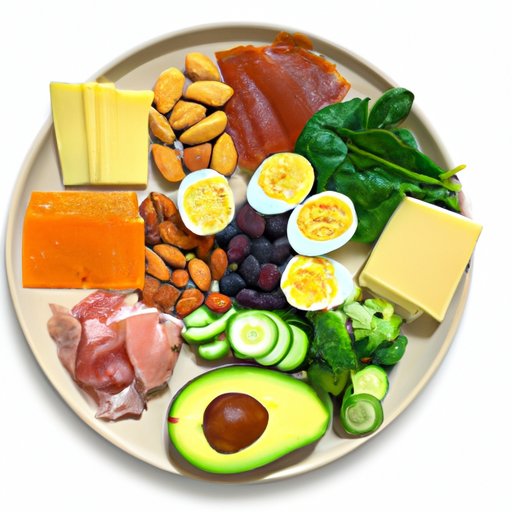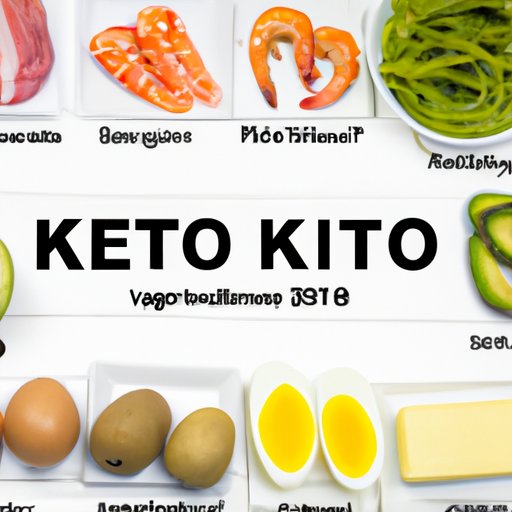
The Ultimate Guide to Keto Diet Foods: All You Need to Know to Get Started
Have you been considering or are already on the keto diet? The keto diet is a popular low-carb, high-fat diet that has been shown to have many health benefits, including weight loss and improved blood sugar control. For those who are new to the keto diet, it is crucial to understand what foods are considered keto-friendly and which ones aren’t. In this article, we will take a comprehensive look at keto diet foods, explain the science behind the diet, and provide tips on how to navigate the grocery store to create a successful keto meal plan.
What is the Keto Diet?
The keto diet is a low-carb, high-fat diet that aims to put your body into a state of ketosis. Ketosis is a metabolic state in which your body runs on stored fat instead of carbohydrates. When you consume a low amount of carbohydrates, your body begins to break down fat into molecules known as ketone bodies. These ketones serve as a source of energy for the body instead of glucose, which is derived from carbohydrates. This shift in metabolic processes changes how your body burns fuel and is the root of the many health benefits associated with the keto diet.
Benefits of the Keto Diet
Before we dive into keto-friendly foods, let’s look at some of the benefits of the keto diet.
- Weight loss: The keto diet has been shown to be very effective for weight loss. Studies have found that people who follow the keto diet tend to lose more weight than those on low-fat diets.
- Improved blood sugar control: The keto diet is particularly useful for people with type two diabetes because it can help lower blood sugar levels.
- Reduced inflammation: The keto diet has been shown to reduce inflammation in the body, which can help with conditions such as rheumatoid arthritis and other autoimmune diseases.
- Improved brain function: The keto diet has been shown to improve cognitive function in people with neurological disorders such as epilepsy and Alzheimer’s disease.
Foods to Avoid on the Keto Diet
In order to achieve ketosis, it is essential to avoid certain foods.
- Sugars: This includes all types of sugar, such as honey, maple syrup, and agave nectar. Most processed foods, such as baked goods and candy, contain high amounts of sugar.
- Grains: This includes all types of grains, including bread, pasta, and cereal. Grains contain carbohydrates, which the keto diet limits.
- Fruits: Most fruits are high in carbohydrates and should be avoided on the keto diet. Small quantities of berries such as raspberries and strawberries can be consumed in moderation.
- Root vegetables: This includes starchy vegetables such as potatoes, sweet potatoes, and carrots.
- Processed foods: Foods such as chips, crackers, and other processed snacks are high in carbohydrates and should be avoided.
Foods to Eat on the Keto Diet
Fortunately, there are plenty of foods that are keto-friendly.
- Low-carb vegetables: These include leafy greens, broccoli, cauliflower, and zucchini.
- High-fat dairy products: Cheese, butter, and cream are great sources of healthy fats.
- Nuts and seeds: Almonds, walnuts, and chia seeds are all great options.
- Healthy oils: Olive oil, coconut oil, and avocado oil are all excellent sources of healthy fats.
- Meat, poultry, and seafood: These are all great sources of protein and healthy fats.
How to Calculate Daily Macros
It is essential to know how many macros you should be consuming on the keto diet. Typically, the keto diet requires consuming 70-80% of your daily calories from fats, 15-20% from protein, and 5-10% from carbohydrates. To calculate your daily macros, you can use a free online calculator, such as the one from KetoDiet Buddy.
Keto Kitchen Staples: Foods to Stock Up on for a Successful Diet
To ensure that you stay on track with the keto diet, it is crucial to stock up on keto-friendly foods. Here are some essential keto diet staples:
Low-carb vegetables
Vegetables are an essential part of the keto diet, but it is important to choose ones that are low in carbohydrates. Leafy greens such as spinach and kale are great options, as are broccoli, cauliflower, and zucchini.
High-fat dairy products
Dairy products such as cheese, butter, and cream are excellent sources of healthy fats. Be sure to choose full-fat options as they are more keto-friendly than low-fat varieties.
Nuts and seeds
Nuts and seeds are a great source of healthy fats and protein. Almonds, walnuts, chia seeds, and flaxseeds are all great options.
Healthy oils
Oils such as olive oil, coconut oil, and avocado oil are all great sources of healthy fats. Use them in cooking and in salad dressings.
Meat, poultry, and seafood
Meat, poultry, and seafood are all great sources of protein and healthy fats. Be sure to choose grass-fed and organic options when possible.

What to Eat on the Keto Diet: A Comprehensive List of Foods
Here is a comprehensive list of foods that are keto-friendly.
Vegetables
- Leafy greens: Spinach, kale, lettuce, and more.
- Cruciferous vegetables: Broccoli, cauliflower, cabbage, and more.
- Avocado: A high-fat and low-carb fruit that is perfect for the keto diet.
- Tomatoes: Relatively low in carbs and high in fiber.
Fruits
- Berries: Strawberries, blackberries, raspberries, and blueberries are all relatively low in carbs and full of nutrients.
Grains
While most grains are off-limits on the keto diet, there are some keto-friendly options.
- Quinoa: A gluten-free grain that is high in protein and low in carbs.
- Flaxseed: This is a low-carb grain that is rich in fiber and healthy fats.
Dairy
- Cheese: Most types of cheese are low in carbs and high in fat, making them perfect for the keto diet.
- Butter: High in healthy fats and perfect for cooking.
- Yogurt: Greek yogurt is a great source of protein and healthy fats. Choose unsweetened varieties to avoid added sugars.
Meat, Poultry, and Seafood
- Beef: Choose grass-fed and organic options when possible.
- Chicken: A great source of protein and healthy fats.
- Fish: Salmon, mackerel, and sardines are all excellent sources of omega-3 fatty acids and protein.
- Shellfish: Crab, shrimp, and lobster are all low in carbs and high in protein.
Fats and Oils
- Olive oil: This is a healthy oil that is high in monounsaturated fats.
- Coconut oil: A great source of healthy saturated fats.
- Avocado oil: A great option for cooking due to its high smoke point.
Top 10 Foods to Incorporate into Your Keto Diet for Optimal Results
These are the top 10 foods to incorporate into your keto diet for optimal results:
- Avocado: High in healthy monounsaturated fats and fiber.
- Coconut oil: A great source of healthy saturated fats.
- Olive oil: This is a healthy oil that is high in monounsaturated fats.
- Butter: High in healthy fats and perfect for cooking.
- Cheese: Most types of cheese are low in carbs and high in fat.
- Nuts and seeds: Almonds, walnuts, and chia seeds are all great options.
- Leafy greens: Spinach, kale, and other leafy greens are excellent sources of fiber and nutrients.
- Berries: Relatively low in carbs and full of nutrients.
- Broccoli: A low-carb vegetable that is high in dietary fiber and vital nutrients.
- Salmon: High in omega-3 fatty acids and protein.
Navigating the Grocery Store for Keto-Friendly Foods
The grocery store can be a challenging place for those on the keto diet. Here are some tips for navigating the store:
Tips for Reading Labels
It is essential to read labels when shopping for keto-friendly foods. Here are some things to look for:
- Total carbs: Be sure to choose foods that are low in carbs.
- Added sugars: Avoid foods with added sugars such as high fructose corn syrup.
- Net carbs: Calculate net carbs by subtracting fiber from total carbs.
Alternative Flours and Sweeteners
The keto diet limits all-purpose flour and sugar, but there are keto-friendly alternatives available.
- Coconut flour: A low-carb, high-fiber alternative to all-purpose flour.
- Almond flour: Low in carbs and high in protein.
- Stevia: A natural, low-calorie sweetener that is perfect for the keto diet.
Snack Options
Here are some keto-friendly snack options:
- Nuts and seeds
- Hard-boiled eggs
- Cheese sticks
- Beef jerky
Beverages
Avoid sugary drinks such as sodas and sports drinks on the keto diet. Instead, choose water, sparkling water, and unsweetened tea and coffee.
Meal Planning for the Keto Diet: How to Build a Balanced Plate
Here are some tips for balancing your keto meals:
Macro Goals for the Keto Diet
The keto diet typically requires consuming 70-80% of your daily calories from fats, 15-20% from protein, and 5-10% from carbohydrates.
Example Meal Plan
Here is an example of a well-balanced keto meal:
- Grilled salmon with a side salad topped with olive oil and balsamic vinegar dressing
- Steamed broccoli with melted butter
- Snack: Almonds
Importance of Variety and Balance in Diet
It is important to vary your meals to prevent boredom and provide your body with a range of nutrients. Be sure to include a balance of healthy fats, protein, and carbohydrates in each meal.
Keto Snacking: Delicious and Satisfying Foods to Keep You on Track
Snacking is a great way to stay on track with your keto diet. Here are some keto-friendly snacks:
- Cheese sticks
- Beef jerky
- Hard-boiled eggs
- Almonds
- Guacamole with celery sticks
- Zucchini chips
Tips for Avoiding Common Pitfalls
Be sure to plan ahead and bring keto-friendly snacks with you so that you are not tempted by unhealthy options. Also, be sure to practice portion control to avoid overeating.
Importance of Portion Control
While most keto foods are healthy, it is essential to practice portion control to avoid overeating and surpassing your daily macros.
Conclusion
In conclusion, the keto diet is an excellent way to improve your health, lose weight, and feel great. By focusing on keto-friendly foods and practicing portion control, you can achieve your health and wellness goals. Remember to vary your meals, choose healthy, high-fat foods, and always read labels while grocery shopping. With these tips, you can stay on track and make the best choices for your health.





